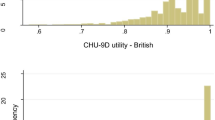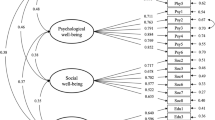Abstract
The objective of this study was to evaluate the reliability and construct validity of the Chinese parent form (PF50) and child form (CF87) of the Child Health Questionnaire (CHQ). Methods: To assess the construct validity and reliability of the Chinese versions, we invited 1099 parents of healthy children and 816 school children to complete the Chinese CHQ-PF50 and CHQ-CF87, respectively. Results: Psychometric analysis on item convergent validity and discriminant validity showed ≥99% rates of success for all 10 scales in the CF87 and ≥94% for all but one scale in the PF50, the exception being general health scale (86%). We observed minimal floor effects for both questionnaires, but substantial ceiling effects for five scales in both the PF50 and CF87 (physical functioning, role-emotional/behavioral, role-physical, bodily pain and family activities). A substantially lower ceiling effect was observed for the physical scale and bodily pain in the CF87 (19% and 25%, respectively) relative to the PF50 (46% and 42%, respectively). The median alpha coefficient for CF87 and PF50 was 0.90 (range, 0.80–0.94) and 0.78 (range, 0.44–0.88), respectively. Conclusions:Our findings suggest that the Chinese CHQ-PF50 and CHQ-CF87 are robust and sufficiently reliable for group comparisons and perhaps also for use in other Chinese populations.
Similar content being viewed by others
References
L. Nordenfelt (1993) Quality of Life, Health and Happiness Ashgate Publishing Company Aldershot.
EF Juniper GH Guyatt DH Feeny et al. (1996) ArticleTitleMeasuring quality of life in children with asthma Qual Life Res. 5 35–46 Occurrence Handle8901365
WR Dunn M. Vitale (2003) ArticleTitlePediatric orthopaedic outcome studies Curr Opin Orthop. 14 IssueID6 375–377
CM Duffy L Arsenault KNW Duffy et al. (1997) ArticleTitleThe juvenile arthritis quality of life questionnaire-development of a new responsive index for juvenile rheumatoid arthritis and juvenile spondyloarthritides J Rheumatol. 24 738–746 Occurrence Handle9101511
JYY Ng SF. Tam (2000) ArticleTitleEffect of exercise-based cardiac rehabilitation on mobility and self-esteem of persons after cardiac surgery Percept Mot Skills. 91 107–114 Occurrence Handle11011880
JYY Ng SF Tam WW Yew WK. Lam (1999) ArticleTitleEffects of video modeling on self-efficacy and exercise performance of COPD patients Soc Behav Pers. 27 475–476
M Bullinger S Schmidt C. Petersen (2002) ArticleTitleThe disakids group Assessing quality of life of children with chronic health conditions and disabilities: A European approach Int J Rehabil Res. 25 IssueID3 197–206 Occurrence Handle12352173
C Eiser MEM. Jenney (1996) ArticleTitle1996 Measuring symptomatic benefit and quality of life in paediatric oncology Br J Cancer. 73 1313–1316 Occurrence Handle8645572
CA Warnes R Liberthson GK Danielson et al. (2001) ArticleTitleTask force 1: The changing profile of congenital heart disease in adult life J Am Coll Cardiol. 37 IssueID5 1170–1175 Occurrence Handle11300418
C Wren JJ. O’ Sullivan (2001) ArticleTitleSurvival with congenital heart disease and need for follow up in adult life Heart. 85 438–443 Occurrence Handle11250973
EM Alonso NC Mattson E Sweet et al. (2003) ArticleTitleFunctional outcome of pediatric liver transplantation J Pediatr Gastroenterol Nutr. 37 IssueID2 155–160 Occurrence Handle12883302
FD Armstrong SR Toledano K Miloslavich et al. (1999) ArticleTitleThe Miami pediatric quality of life questionnaire: Parent scale Int J Cancer. 12 IssueID(Suppl 11–17
JM Landgraf L Abetz JE. Ware (1999) The CHQ User’s Manual Second Printing, HealthAct Boston, MA.
EF Juniper WC Howland NB Roberts et al. (1998) ArticleTitleMeasuring quality of life in children with rhinoconjunctivitis J Allergy Clin Immunol. 101 IssueID2 163–170 Occurrence Handle9500748
JW Varni M Seid CA. Rode (1999) ArticleTitleThe PedsQL™: Measurement model for the pediatric quality of life inventory Med Care. 37 126–139 Occurrence Handle10024117
JW Varni M Seid PS. Kurtin (2001) ArticleTitlePedsQL 4.0: Reliability and validity of the pediatric quality of life inventory” version 4.0 generic score scales in healthy and patient populations Med Care. 39 800–812 Occurrence Handle11468499
CLK Lam B Gandek XS Ren MS. Chan (1998) ArticleTitleTest of scaling assumptions and construct validity of the Chinese (HK) version of the SF-36 health survey J Clin Epidemiol. 51 IssueID11 1139–1147 Occurrence Handle9817131
XS Ren B Amick L Zhou B. Gandek (1998) ArticleTitleTranslation and psychometric evaluation of a Chinese Version of the SF-36 Health Survey in the United States J Clin Epidemiol. 51 IssueID11 1129–1138 Occurrence Handle9817130
JM Landgraf E Maunsell K Nixon-Speechley et al. (1998) ArticleTitleCanadian-French, German, and United Kingdom versions of the Child Health Questionnaire (CHQ-PF50): Methodology and preliminary item scaling results Qual Life Res. 7 IssueID5 433–445 Occurrence Handle9691723
U Norrby LA. Nordholm (2001) ArticleTitleReliability and validity of a Swedish version of Child Health Questionnaire (CHQ) Qual Life Res. 10 IssueID3 287
HJ Loonen BH Derkx BF Last MA. Grootenhuis (2000) ArticleTitleTranslation, adaptation and subsequent validation of a new health related quality of life questionnaire for children with inflammatory bowel disease Qual Life Res. 9 IssueID3 297
T Hayashi RD. Hays (1987) ArticleTitleA microcomputer program for analyzing multi-trait-multimethod matrices Behav Res Meth Instrum Comput. 19 IssueID3 345–348
JE Ware WJ Harris B Gandek et al. (1997) MAP-R for Windows: Multitrait Multi-Item Analysis Program-Revised User’s Guide. Health Assessment Lab Boston, MA.
DT Campbell DW. Fiske (1959) ArticleTitleConvergent and discriminant validation by the multitrait-multimethod matrix Psychol Bull. 56 85–105
KL Howard GC. Forehand (1962) ArticleTitleA method for correcting item-total correlations for the effect of relevant item inclusion Education and Psychological Measurement. 22 731
JC Nunnally IH. Bernstein (1994) Psychometric Theory EditionNumber2 McGraw-Hill Inc . New York.
LJ. Cronbach (1951) ArticleTitleCoefficient alpha and the internal structure of tests Psychometrika. 16 297–334
GC. Helmsteader (1964) Principles of Psychological Measurement. Appleton-Centry Crofts, Inc. New York.
Ci Hai – Chinese Phrases Dictionary, 2nd ed. (1948). Shanghai: Chinese Bookstore
NCM Theunissen TGC Vogels HM Koopman et al. (1998) ArticleTitleThe proxy problem: Child report versus parent report in health-related quality of life research Qual Life Res. 7 387–397 Occurrence Handle9691719
C Rodary N Bellon JM Landgraf et al. (2001) ArticleTitleThe Child Health Questionnaire (CHQ): Comparison of the quality of life (qol) scores obtained by the parent report (PF50) and the self-report (CF87) Qual Life Res. 10 IssueID3 216
C Edelbrock AJ Costello MK Dulcan et al. (1986) ArticleTitleParent–child agreement on child psychiatric symptoms assessed via structured interview J Child Psychol Psychiatr. 27 181–190
F Petito RA. Cummins (2000) ArticleTitleQuality of life in adolescence: The role of perceived control, parenting style, and social support Behav Change. 17 IssueID3 196–207
M Bullinger R Anderson D Cella N. Aaronson (1993) ArticleTitleDeveloping and evaluating cross-cultural instruments from minimum requirements to optimal models Qual Life Res. 2 451–459 Occurrence Handle8161979
H Raat JM Landgraf GJ Bonsel et al. (2002) ArticleTitleReliability and validity of the Child Health Questionnaire-Child Form (CHQ-CF87) in a Dutch adolescent population Qual Life Res. 11 IssueID6 575–581 Occurrence Handle12206578
Author information
Authors and Affiliations
Corresponding author
Rights and permissions
About this article
Cite this article
Ng, J.Y.Y., Landgraf, J.M., Chiu, C.S.W. et al. Preliminary evidence on the measurement properties of the Chinese version of the child health questionnaire, parent form (CHQ-PF50) and child form (CHQ-CF87). Qual Life Res 14, 1775–1781 (2005). https://doi.org/10.1007/s11136-005-1005-1
Accepted:
Issue Date:
DOI: https://doi.org/10.1007/s11136-005-1005-1




